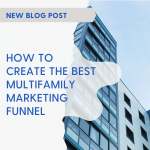
A business’s online presence is essential for growth, especially for apartments and leasing. To be found online, you must use practices that ensure you appear in searches. But a web presence goes beyond search engines. Your online presence includes how people see and think about your business. In short, your digital presence is like a storefront where visitors form their thoughts and opinions about your offerings.
Online visibility and marketing for apartments enhance the digital presence of leasing properties. These methods are crucial for attracting potential residents and offering an immersive, informative, and engaging online experience.
With the right marketing tactics, you can ensure prospects who find you online are satisfied. Besides a strong online presence, provide a clear path through your leasing process to help prospects want to become residents.
The Foundation Of Your Web Presence
Discover what makes up a multifamily online presence and improve your marketing with these tips! A stronger local online presence will help your property grow and gain new leases. These basic strategies will ensure a smooth leasing experience and reassure you that you aren’t losing potential prospects.
Many factors influence your online presence and visibility. There is no magic bullet for success, but a mix of strategies and tips will help you grow over time. When these elements work together, they boost your property’s online searches, visibility, and traffic. Focus on these key elements to ensure your property’s visibility improves:
- Responsive Website
- Property Listings
- Contact Information
- Online Leasing
- Social Media Profiles
- Community Blog
- Online Reviews and Testimonials
- Virtual Tours
- Amenities Showcase
- Online Resident Portal
- Online Advertising
- Search Engine Optimization (SEO)
- Professional Photography
- Floor Plans and Pricing
- Consider Paid Advertising

The Digital Landscape for Apartment Rentals
Digital marketing in real estate began with the internet. Since then, it has evolved with new technology like smartphones, virtual reality, and data analysis tools. This has transformed how we buy and sell homes today.
Like most industries, the apartment industry has evolved too. Today, modern apartment marketing trends use technology to enhance their online presence. When enhancing your rental strategy, consider current multifamily trends.
Current trends include immersive virtual tours, big data for targeted marketing, AI for personalized experiences, and a focus on mobile optimization due to increased mobile searches.
Online behavior trends can also impact apartment searches and tenant characteristics. Reviewing the multifamily digital landscape and exploring changes can teach you a lot. Your digital approach plays a crucial role in attracting new tenants. Review the trends below to prepare your property for growth!
- Increased use of virtual tours and 3D walkthroughs provides a more immersive online viewing experience for potential tenants.
- One impressive trend is using augmented reality (AR) and virtual reality (VR) for apartment viewings. This technology has transformed property showcases, offering an immersive experience that static images or traditional tours can’t match.
- Experimenting with AR and VR technologies for virtual staging and interactive property exploration.
- The rising popularity of video content, like property walkthroughs, neighborhood highlights, and resident testimonials, enhances storytelling and engagement.
- Websites with videos can keep users on the page up to 88% longer.
- Collaborating with local influencers and bloggers promotes apartment communities and reaches a broader audience.
- Implementing chatbots and AI-powered tools for instant communication, answering queries, and providing information to potential tenants on websites.
- Encouraging residents to share their experiences through reviews, photos, and testimonials contributes to authentic user-generated content. Research shows that over 70% of tenants use online reviews as a primary step in finding a new apartment.
- Increased focus on localized search engine optimization (SEO) ensures apartments appear in relevant local searches.
- With 80% of internet users owning a smartphone, mobile-friendly websites are crucial for reaching potential tenants. Ensuring mobile-friendly websites and applications caters to the increasing number of users accessing information through mobile devices.
- Adopting personalized marketing strategies, including targeted email campaigns and content tailored to specific tenant demographics and preferences.
- Promoting apartments with integrated smart home technologies for security, energy efficiency, and convenience.
- Twenty-five percent of apartment hunters consider smart home features a deciding factor. Integrating and highlighting these technologies can make your property more appealing.
- Developing and using community-specific apps allows residents to connect, access services, and stay informed about events.
Optimize Your Property Listings
Your online listings reflect your property to future residents! While many residents may find you by driving by or due to local proximity, those who find you online will make their decisions based on your property listing. Consider your property listings as important as a physical location or brick-and-mortar store.
Just as you would present your best information and imagery in person, do the same online. Follow the steps below to optimize your property listing and create the best versions possible:
- Include clear, high-resolution images that showcase the best features of the property.
- Capture different angles of each room and highlight unique selling points.
- Properties with professional photos see a 50% higher lead conversion rate.
Virtual Tours and 3D Walkthroughs:
- Offer virtual tours or 3D walkthroughs to provide an immersive experience for online visitors.
- Enable potential tenants to explore the property remotely.
Accurate and Detailed Descriptions:
- Write compelling and accurate property descriptions.
- Highlight key features, amenities, and any recent upgrades or renovations.
- List and describe the amenities available in the property and the community.
- Mention features like fitness centers, pools, in-unit appliances, and pet-friendly policies.
Provide Floor Plans:
- Include detailed floor plans to help potential tenants visualize the layout.
- Label rooms and dimensions for each space.
Local Area Information:
- Include information about the neighborhood, local attractions, schools, parks, and public transportation.
- Highlight proximity to shopping centers, restaurants, and entertainment.
Pricing Information:
- Clearly state the rental price and any additional fees.
- Offer incentives, discounts, or special promotions if applicable.
Clear Contact Information:
- Ensure that your contact information is prominently displayed.
- Include multiple contact options such as phone numbers, email addresses, and a contact form.
SEO Optimization:
- Use relevant keywords in your property description and title to improve search engine visibility.
- Optimize meta tags and descriptions for better search engine performance.
- Long-tail keywords in real estate searches have a 36% higher conversion rate than generic searches. Tailor your website’s content to include specific, long-tail keywords.
- Use neighborhood-specific phrases and amenity-focused terms in your content. This approach improves SEO and makes your site’s traffic more relevant and likely to convert into leases.
- Hire a professional copywriter to write engaging and persuasive property descriptions.
- Use language that emphasizes the lifestyle and benefits of living on the property.
Highlight Energy Efficiency:
- If applicable, highlight any energy-efficient features in the property, such as solar panels, smart thermostats, or energy-efficient appliances.
Include Tenant Testimonials:
- Feature positive testimonials from previous tenants to build trust with potential renters.
Online Reviews and Ratings:
- Encourage satisfied tenants to leave positive reviews on online platforms.
- Respond promptly to any negative reviews with solutions or explanations.
Multiple Listing Platforms:
- Use multiple online listing platforms to increase the property’s exposure.
- Make sure the information is consistent across all platforms.
Highlight Security Measures:
- Highlight security features such as surveillance systems, secure entry systems, and well-lit parking areas.
Promote Community Events:
- If applicable, mention any upcoming community events or activities in the property’s listing.
- Showcase a vibrant community atmosphere.
Implementing these strategies can make your property listings more attractive to potential tenants, increasing the chances of successful leasing.

The Importance Of Apartment Web Design
One of the most important elements to consider when evaluating your online presence is your apartment website design. If you’re doing everything to lead people to your website, you don’t want the design to be poor. Your website design includes the user experience, page speed, navigation, content, photos, and more. If your website isn’t professional and strategic, your online visibility will be useless.
As you plan the next step for more online visibility, look at your website’s current impact. Conduct surveys to get feedback from current and future residents to identify where it falls short. Use tools like Google Analytics and SEO strategies to review the most visited pages and your traffic breakdown. When considering your apartment website design, ask yourself the following questions:
- Is the property information detailed and comprehensive?
- Does the website provide clear details about the location, contact information amenities, and features of the apartment?
- Are there detailed floor plans available for each apartment unit?
- Are there high-quality photos of the apartments and common areas that realistically represent the property?
- Does the website offer virtual tours for a more immersive experience?
- Is pricing information clear and transparent?
- Are there details about lease terms, deposits, and any additional fees?
- Is there information on apartment availability and move-in dates?
- Are all amenities listed with detailed descriptions?
- Are there details on nearby schools, public transportation, and local attractions?
- Are there customer reviews or testimonials available on the website?
- Is contact information readily available for the property management or leasing office.
- Is the website design responsive and mobile-friendly?
- Can users easily navigate the site on different devices?
- Are the terms of service, privacy policy, and other legal information easily accessible?
- Is there clarity on the application process, screening criteria, and lease agreements?
- Does the website have interactive features, such as a map with nearby points of interest?
- Is the website accessible to users with disabilities and compliant with accessibility standards?

Market Your Content
To improve your online visibility, consider the key role of content marketing. It’s a powerful tool to engage and attract potential residents. In the competitive multifamily market, the right content sets your property apart and encourages people to visit your website.
A good content marketing strategy can distinguish your property and connect with your target audience. Informative blog posts, engaging videos, and virtual tours showcase an apartment’s unique features and provide insights into the neighborhood, amenities, and lifestyle.
Strategic content increases the chances of potential tenants choosing your property over others. Content marketing is essential for apartments to enhance their online presence and connect meaningfully with their target audience.
Build a Solid Reputation
Most people make consumer decisions based on online reviews. Prospects look at community reviews and how you interact with current residents. Properties that don’t respond to residents’ questions or issues often lose potential tenants. Your online interactions can make or break your property’s appeal.
Prospects are increasingly searching for information about your community online. By prioritizing your online presence, you will attract a wider audience and generate higher-quality leads. Focusing on multifamily reputation management will improve your apartment marketing efforts. Your community’s online presence is crucial.
Reputation management involves strategies to enhance your property’s online presence, including review management, social media, and online interactions. These components work together to benefit your multifamily community more than other methods. Since prospects seek information online, having a strong voice is essential.
Multifamily reputation management aims to establish an online presence that generates high-quality leads and leases. By clearly defining your online brand, you can connect with prospects more personally and meaningfully. Online reviews and social media will elevate your apartment marketing.
Monitor and Adjust Strategies
As you grow your property and online visibility, you need the right data and processes to assess your progress accurately. The right tools help you see if your traffic is increasing and review specific analytics. The right data helps you identify pitfalls and know where to adjust your strategy. Use the steps below to create the best plan for monitoring your web presence and ensuring you can be found online.
Step 1: Define Key Metrics and Goals
Start by outlining the objectives of your online visibility efforts. Determine key metrics such as website traffic, conversion rates, and engagement on various online platforms. Establish specific, measurable goals to track your campaign’s success.
Step 2: Conduct a Website Audit
To gather initial information, evaluate the effectiveness of your apartment website by assessing factors like speed, mobile responsiveness, and the overall user experience. Ensure all relevant information is easily accessible. Use tools like Google Analytics to gather data on traffic, page views, and user behavior.
Step 3: Use Online Analytics Tools
Use online analytics tools to track and measure your online visibility. Tools like Google Analytics, Google Search Console, and other SEO tools provide insights into website performance, search engine rankings, and user behavior. Monitor social media analytics to assess your social media presence. Review these analytics regularly to identify trends and areas for improvement.
Actively seek feedback from current and potential tenants. Use surveys, reviews, and social media comments to understand their preferences and expectations. Adjust your online strategy based on this feedback. Continuously improve to better meet your target audience’s needs and interests.
If you lack the time or expertise to manage your online presence, Market Apartments can help. Contact us today to boost your property’s visibility, attract more tenants, and ensure your leasing process runs smoothly. Let our expertise handle the digital marketing so you can focus on providing excellent living experiences for your residents.
Get a stronger online presence today! Work with apartment marketing professionals.
Categorised in: Apartment Marketing
This post was written by Isabella Housel
Isabella Housel is a passionate and versatile professional writer with a deep love for words and a commitment to crafting compelling content that engages, informs, and inspires. With many years of experience in the industry, she has honed her skills across various genres, from creative storytelling to informative articles and technical documentation.





